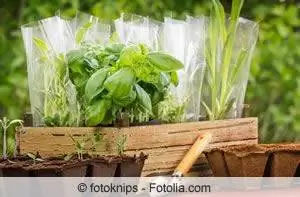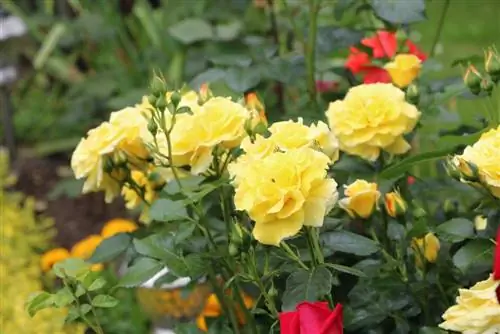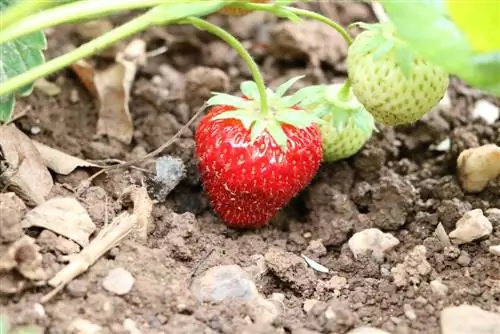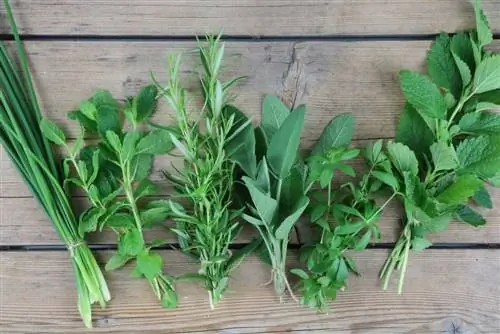- Author admin [email protected].
- Public 2023-12-17 03:39.
- Last modified 2025-01-24 12:45.
The cultivation of aromatic herbs is a good thing if the young plants are planted in the ground at exactly the right time. Given the immense variety of varieties, there is uncertainty among hobby gardeners on this very point. The question rightly arises as to whether hardy and exotic herb plants should be planted at different times. Don't feel in the dark any longer, because the following lines will provide you with comprehensive information about the best time to plant herbs in the garden and on the balcony.
This planting time is always right
Regardless of whether the herbs were grown behind glass or purchased ready-made in the garden center, you can be on the safe side with the following planting date:
- The best time to plant herbs in the garden and on the balcony begins at the beginning of May
- Ideally, the young plants come into the ground after the Ice Saints from May 15th
For exotic herb varieties, a date after 'Cold Sophie' is an option at the earliest, when experience shows that delayed ground frosts are no longer to be expected. Even winter-hardy herbs do not immediately have the frost resistance that they do when they are older. Having just outgrown their cultivation pots, they are just as defenseless against sub-zero temperatures as their tropical counterparts. Only through careful care in conjunction with hardening in the open air do wormwood, chives or rocket develop the robust constitution that qualifies them for perennial cultivation outdoors.
Proper Planting
Deciding on the best planting time alone does not create magnificent herb plants that produce a bountiful harvest. In order for the young plants to take root quickly, it is important to plant them correctly in the optimal location. Here's how to do it:
- All herbs need a sunny, warm and protected location
- With a few exceptions, the soil should be humus, lean and fresh and moist
- The crop rotation must be observed, because herbs usually do not get along with themselves or their counterparts
- At the chosen location, loosen the soil thoroughly and weed thoroughly
- Optimize the soil by adding sifted compost, granulated cattle manure and a little sand
- Dig planting holes with twice the volume of the root ball
- Unpot the young plants that have been soaked in water beforehand, place them in the ground and water them
- Make sure there is sufficient planting distance and use overgrown varieties with root barriers
Planting herbs in pots on the balcony follows a similar pattern. Commercially available herbal soil has proven to be a suitable substrate. Alternatively, a mix of clay-containing garden soil, compost, sand, horn shavings and perlite is recommended. The few heavy feeders, such as basil, thrive in compost-based potting soil enriched with sand or expanded clay. Drainage at the bottom of the pot above the water drain is essential. To do this, use inorganic material such as pebbles, grit or crushed shards of pottery. Insert a water- and air-permeable fleece between the drainage and the substrate.
Tip:
Exotic, cold-sensitive herb varieties are covered with garden fleece at night until the danger of cold weather has passed at the beginning of June.
Direct sowing possible from March
A variety of hardy, hardy herbs can be sown directly into the bed well before the best planting time. This has the advantage that the resulting young plants are already well hardened. The following overview gives the dates for the most important herbs in the garden and on the balcony:
- Savory: from the beginning of April
- Borage: from mid-March
- Dill: from the beginning of April
- Chamomile: from the beginning of March
- Chervil: from the beginning of March
- Lovage: mid-March
- Parsley: frost sowing from February
- Sage: from the end of April
- Sorrel: end of March
- Chives: from the end of April
- Hyssop: End of April
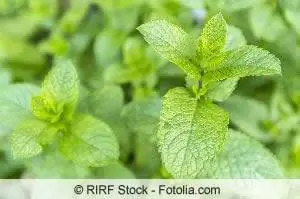
Proper preparation of the bed plays an important role in ensuring that the seeds sprout. All weeds are removed, as are stones and roots. After the soil has been thoroughly loosened with the digging fork, work in a 2 to 3 centimeter high layer of sifted compost. Before the seeds are sown, the rake should ensure that the soil is as finely crumbly as possible. Ideally, you should sprinkle another layer of compost, sand or vermiculite over the seeds and moisten everything with a fine spray. A fine-mesh net protects the bed from voracious pests. Until the seeds germinate, thorough weeding is on the care program every few days. In addition, the seeds must neither dry out nor float in water. Once the first leaves have developed, the weakest seedlings are sorted out to make space.
Tip:
A mobile polytunnel protects the bed from the worst weather influences with direct sowing.
Growing behind glass from April
Sowing directly into the bed or the bucket on the balcony is fraught with numerous imponderables, especially due to the harsh weather conditions and the threat of diseases and pests. In contrast, growing indoors creates the best conditions for both tropical and local herbs. Since the vast majority of herb seeds germinate quickly, a date from the beginning of April should be considered for sowing. If you sow seeds earlier, there is a risk that the young plants that have matured too early will develop long, weak horny shoots on the windowsill. When the best planting time after the Ice Saints is just around the corner, the plants have already exhausted themselves to such an extent that it is difficult for them to gain a foothold outdoors. Following these instructions, you can sow seeds behind glass:
- Soak the seeds in lukewarm chamomile tea for 6-12 hours
- Fill a seed tray or small pot with peat sand, coconut fiber, perlite or seed soil
- Do not spread the seeds too closely
- Do not cover light germinators with substrate
- Moisten the seeds with water from the spray bottle
- Cover the seed containers with glass or plastic wrap
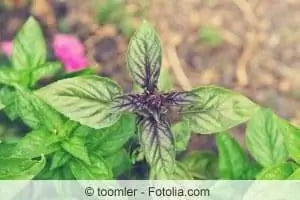
In a partially shaded window seat, germination begins on average within 2 to 4 weeks at temperatures of 20 to 25 degrees Celsius. Any cover has fulfilled its function and is removed. Once the seedlings have reached a height of 5 centimeters and have developed 2 to 3 pairs of leaves, they are transplanted into individual pots. The young plants must not dry out until the planting date.
Special case of cold germination
A few types of herbs are cold germinators, such as wild garlic, rue, angelica or woodruff. Although the same deadlines apply to these seeds as to normal germinators, an additional step is required here. To get these seeds into the mood to germinate, they experience a cold stimulus. To do this, store them in moist sand in the vegetable compartment of the refrigerator for 4 to 6 weeks. If that is too time-consuming for you, you should prefer direct sowing from February, where Mother Nature is responsible for the stratification.
Conclusion
By choosing the best time to plant herbs in the garden and on the balcony, prudent hobby gardeners set the course for the best growth and a rich harvest. You are on the safe side if you plant the young plants you have grown yourself or purchased ready-made in the bed or pot from mid-May. Alternatively, winter-hardy herb varieties can be sown directly into the bed from March onwards, which is of course associated with considerable risks. Growing behind glass, on the other hand, scores points with vital young plants, as long as sowing is not started before the beginning of April.

